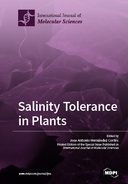Explore

Salinity Tolerance in Plants
0 Ungluers have
Faved this Work
Login to Fave
Salt stress is one of the most damaging abiotic stresses because most crop plants are susceptible to salinity to different degrees. According to the FAO, about 800 million Has of land are affected by salinity worldwide. Unfortunately, this situation will worsen in the context of climate change, where there will be an overall increase in temperature and a decrease in average annual rainfall worldwide. This Special Issue presents different research works and reviews on the response of plants to salinity, focused from different points of view: physiological, biochemical, and molecular levels. Although an important part of the studies on the response to salinity have been carried out with Arabidopsis plants, the use of other species with agronomic interest is also notable, including woody plants. Most of the conducted studies in this Special Issue were focused on the identification and characterization of candidate genes for salt tolerance in higher plants. This identification would provide valuable information about the molecular and genetic mechanisms involved in the salt tolerance response, and it also supplies important resources to breeding programs for salt tolerance in plants.
This book is included in DOAB.
Why read this book? Have your say.
You must be logged in to comment.
Rights Information
Are you the author or publisher of this work? If so, you can claim it as yours by registering as an Unglue.it rights holder.Downloads
This work has been downloaded 332 times via unglue.it ebook links.
- 53 - pdf (CC BY-NC-ND) at Unglue.it.
Keywords
- ABA
- abiotic stress
- abiotic stresses
- antioxidant enzymes
- antioxidant systems
- Apocyni Veneti Folium
- Arabidopsis
- Arabidopsis thaliana
- ascorbate cycle
- association mapping.
- banana (Musa acuminata L.)
- booting stage
- Brassica napus
- bZIP transcription factors
- CaDHN5
- Capsicum annuum L.
- CDPK
- cell membrane injury
- Chlamydomonas reinhardtii
- chlorophyll fluorescence
- cucumber
- dehydrin
- DEUs
- drought
- drought, osmotic stress
- EST-SSR
- flax
- Genome-Wide Association Study
- genome-wide identification
- Germination
- glycophytes
- Gossypium arboretum
- grapevine
- halophytes
- high salinity
- HKT1
- hydrogen peroxide
- impairment of photosynthesis
- ion homeostasis
- iTRAQ quantification
- J8-1 plum line
- light saturation point
- lipid accumulation
- Lipid Peroxidation
- mandelonitrile
- MaROP5g
- Melatonin
- molecular mechanisms
- multiple bioactive constituents
- Multivariate statistical analysis
- n/a
- Na+
- NaCl stress
- natural variation
- Nitric Oxide
- NMT
- nucleolin
- Oryza sativa
- osmotic stress
- Photosynthesis
- photosystem
- physiological changes
- phytohormone
- Polyamines
- poplars (Populus)
- Proteomics
- Prunus domestica
- Reactive Oxygen Species
- redox homeostasis
- redox signalling
- Rice
- RNA binding protein
- RNA-Seq
- root activity
- ROP
- ROS
- ROS detoxification
- salicylic acid
- Salinity
- salt stress
- Salt tolerance
- salt-stress
- Sapium sebiferum
- signal pathway
- single nucleotide polymorphisms
- SnRK2
- soluble nutrients
- SOS
- SsMAX2
- strigolactones
- TGase
- thema EDItEUR::P Mathematics and Science::PS Biology, life sciences
- transcription factor
- Transcription Factors
- transcriptional activator
- transcriptional regulation
- transcriptome
- transcriptome analysis
- underpinnings of salt stress responses
- VOZ
Links
DOI: 10.3390/books978-3-03921-027-5Editions


